Saving our Skins: Chapter 18. Flies in the Ointment
Atmospheric Reflections from a Lauder Star Gazer
The continuing story of “Saving our Skins”. A "Good News" story, though there are a few remaining caveats ..
Updated September 5, 2021.
Sadly, the enormous success of the Montreal Protocol is largely unheralded. I still see reports in the newspapers from climate deniers, claiming that ozone depletion turned out to be nothing. They appear to be completely unaware that it took concerted – and some may say heroic – actions from a lot of people to save the day. Or perhaps they just prefer to remain wilfully ignorant about the disaster avoided.
Public perception is also out of step with reality. When I tell people of my interest in UV, they often remark that UV is “much stronger nowadays”. That’s another myth, at least as far as changes in the last 30 years or so are concerned. We don’t know much about UV levels prior to the early 1990s because there were very few measurements available. But based on ozone measurements which go back to the 1960s, there’s no reason why it should be significantly higher now. The longest time series of UV available in New Zealand is from Robertson-Berger (R-B) meters, which have provided measurements at Invercargill since the early 1980s. Unfortunately, some of the early data are of questionable quality, because the instrument was damaged by flood waters (twice). The instruments also had a low sensitivity to ozone effects, with signals increasing by only 0.8 percent for each 1 percent reduction in ozone, whereas the true sun burning UV would increase by about 1.2 percent (i.e., a sensitivity 50 percent greater than the R-B meter). But despite these shortcomings, it’s still clear that any long-term trends in UV at that site have been small. And, being closest to Antarctica, that’s the site in New Zealand most likely to have shown any change.

The common Kiwi perception the “UV is much stronger here than Australia or the Pacific Islands” is also wrong. The two most important factors controlling clear-sky UV are the length of the path of sunlight through the atmosphere, which is shortest for high sun elevation angles, and the amount of ozone in the path. Both of those become smaller as you approach the equator. Consequently, UV intensities increase as you approach the equator. The highest values in New Zealand are north of Auckland. And they are higher still in Australia. The perception of higher UV in the south of New Zealand, is guided by the false expectation that it should be higher because it is closer to the ozone hole, which in reality is over a thousand kilometres further south. It’s true that our peak UVI is higher than corresponding northern latitudes, by about 40 percent, but that’s nothing to do with ozone depletion (as explained near the end of chapter 15). And we do have an undeniable problem with skin cancer. Our skin cancer rates are the highest in the world. But that’s not because of ozone depletion. Our UV levels are similar today to what they were before ozone depletion began. And they will probably be similar for the next few decades at least. Our problem is mainly among the fair skinned subset of our population, like me. Our skin types are poorly adapted to the higher UV levels in this part of the world. If you drilled a hole down through the centre of the Earth from Auckland, you would emerge on the other side of the world near Gibraltar. Even the southernmost tip of New Zealand is far closer to the equator than any part of the British Isles.
The country closest to New Zealand’s antipodes is Spain, and Spaniards have much darker skin than Kiwis, because most of our ancestors migrated here from the British Isles. At those much more poleward latitudes, peak UV levels are only half those in New Zealand. The extra melanin in the skin of North African and Spanish people protects them against UV damage. We enjoy an outdoor lifestyle too in New Zealand, where temperatures are cool enough to encourage sun-seeking behaviour. By contrast, in Australia and the Pacific-Islands, where the peak UV is greater, it is usually too hot to stay in the sun for long, and people naturally seek shade. Anthropologists Nina Jablonski and George Chaplin have suggested that light skin colour is an adaptation to low ambient UV levels, and that as populations slowly migrated to more poleward latitudes, those with darker skins were disadvantaged. They argue that while protecting them against high UV in the tropics, their darker skin inhibited the production of vitamin D. A lack of vitamin D inhibits the formation of bones, including the pelvis, which must be well developed for women to successfully give birth. There were no caesarean sections in those days, so the theory goes that the survival rates of infants for mothers with impaired bone development would be lower. I became part of that debate in 1998 after another US anthropologist, John Relethford, noted that latitude-for-latitude, indigenous skin types tended to be darker in the southern hemisphere. He suggested differences in UV could be the cause. When Jablonski and Chaplin disagreed, he asked me to help by providing global UV patterns, which supported his theory. But I think it’s a moot point if UV differences could be a factor, because on those migratory time scales, which are measured in tens of thousands of years or more, the UV may not always have been greater in the southern hemisphere. For example, the Earth-Sun separation would at times have been closest in the Northern Hemisphere summer (not the southern hemisphere summer as at present). And prior to the industrial revolution with its booming population levels, pressures on air quality were much smaller. So, differences in UV extinctions by aerosols between the Northern and Southern hemisphere would have been much smaller than in today’s world. The future is even more uncertain. To coin a remark from the famous Danish physicist Niels Bohr: “It’s extremely difficult to make predictions, especially of the future”. Future fleets of supersonic aircraft flying in the stratosphere are again being considered. The most recent model calculations show that while atmospheric chlorine levels remain high, the effect of emissions of nitrogen oxides from their exhaust would be good for ozone because they would react with chlorine to form chlorine nitrate (ClNO3), which is not harmful to ozone: the two potentially harmful chemicals (NO2 and ClO) neutralize each other. On the other hand, the water vapour that’s also emitted as a product of combustion, would tend to destroy ozone. In the longer-term future, when atmospheric chlorine has declined back to its natural level, the same fleet would become more harmful to the ozone layer, especially within polar regions.[1] Stratospheric NO2 is already increasing, even without that fleet of aircraft, as we showed several years ago from our long term measurements at Lauder. That’s because of increases in its source gas, nitrous oxide. Puzzlingly, as-yet unpublished work suggests that the rate of increase in NO2 has slowed down in the 20 years since that paper was published, despite the accelerating rate of increase for N2O. The cause of that discrepancy is a topic of current research at Lauder. The effect on ozone of these increases in NO2 will depend on the amount of atmospheric chlorine and the temperature of the stratosphere, both of which are currently decreasing. As noted in chapter 10, the net effect will be variable in space and time. Despite these misgivings, the future for ozone recovery looks promising. The concentrations of ozone depleting chemicals are reducing. The amount of ozone in the atmosphere is no longer decreasing and seems to have flattened out or may even be starting to increase. Ozone depletion in Antarctica seems to be past its worst, and UV radiation doesn’t seem to be increasing. In fact, a “super” recovery of ozone is now expected, with ozone levels by the end of the century surpassing those prior to the 1980s. The Montreal Protocol looks to have been so successful that, rather than being concerned about getting too much UV for skin health in summers by the end of the century, perhaps we’ll need to be more concerned about not getting enough UV to maintain vitamin D status in the winter. But other factors associated with climate change, and the move from fossil fuels to clean renewable energy, will be occurring in tandem. The effects on UV of future changes in aerosols and clouds are expected to be bigger than the effects of ozone itself.

But there are still a couple more flies in the ointment. Firstly, there’s volcanic activity, which is unpredictable and potentially damaging to the ozone layer for the next few decades, while atmospheric chlorine levels remain elevated. That’s because large volcanic eruptions can spew material directly into the stratosphere where it can rapidly deplete ozone, as was the case for the eruption of Mt Pinatubo in 1991. The aerosols then provided surfaces for heterogeneous chemistry, the same sort of chemistry that occurs on ice crystals in the Antarctic ozone hole, to occur over a much wider range of latitudes. Some volcanoes can also inject chlorine directly into the atmosphere. For example, when Mt Erebus in Antarctica erupts, plumes of hydrochloric acid (HCl) have been measured by our own group from Lauder. This can be rapidly broken down to chlorine in the upper atmosphere (though this is not the cause of the Antarctic ozone hole because the volcanic plumes from Erebus don’t get high enough in the atmosphere to reach the ozone layer). The other big unknown is whether everybody in the world will continue to comply with the Montreal Protocol. Concern was recently re-kindled by the news in 2018 that concentrations of CFCs weren’t decreasing as fast as they should have, based on the production rates that countries were reporting. Apparently, some manufacturers (or nations) felt they could make more money out of continuing to supply a black market with the banned substances. Previously the finger would have been pointed to “rogue” nations like Gaddafi’s Libya, but nowadays perhaps we need to look closer to home. With Trump’s track record on environmental issues, I wouldn’t put it past him. But the geographical fingerprint of the recent slowdown in recovery suggested that the real source of the problem is unreported emissions from Asia. Subsequently, large-scale manufacturing of CFCs for use in polystyrene was uncovered in China. Although that illicit production has since been reputedly shut down by authorities there, is that really the end of the story? Or was it just the tip of a growing iceberg?
[1]. Puzzlingly, as-yet unpublished work suggests that the rate of increase in NO2 has slowed down in the 20-years since that paper was published, despite the accelerating rate of increase in N2O. The cause of that discrepancy is a topic of current research at Lauder.
Next week. Some questions and some answers. It started as just a bit of frivolity really, but the outcomes turned out to be useful …



